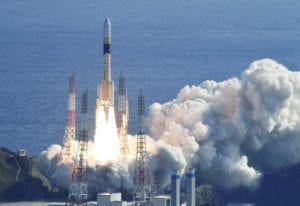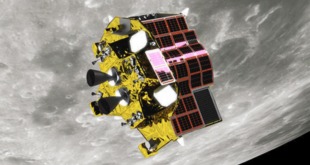
A Mitsubishi Heavy Industries (MHI) H-IIA satellite launch vehicle successfully lofted an electro-optical Intelligence Gathering Satellite (IGS) on behalf of the Japanese Cabinet Office from the Tanegashima Space Centre, Kagoshima Prefecture, in southwest Japan on 9 February 2020.
The launch of the IGS satellite, dubbed IGS Optical 7, was initially scheduled for 27 January 2020 but was scrubbed due to a technical glitch during countdown. The 9 February launch took place at 10:34am local time, and IGS Optical 7 has reportedly been placed in its intended orbit.
The launch of IGS Optical 7 is the eighteenth IGS satellite to have been launched by the Japanese government since 2003. This number also includes two IGS satellites lost in a failed H-IIA launch in November 2003.
Japan currently operates five high-resolution synthetic aperture radar (SAR) imaging and now three electro-optical IGS satellites that monitor military activities by North Korea and China, to include ballistic missile and nuclear weapons tests, naval activities in the South China Sea, East China Sea, the Sea of Japan, and the Western Pacific Ocean.
Japan also uses the IGS satellites to monitor Russian military activities given Tokyo’s longstanding territorial dispute with Moscow over the Kuril Islands, also known as the Northern Territories, to the north of Japan and off the coast of Russia’s Far East.
More recently, both China and Russia have conducted naval and aerial maneuvers in Japanese territorial waters and airspace in order to test Japanese defences and responses. Japan is also deeply concerned about North Korean ballistic missile tests and its nuclear weapons programme, given the hostility of Pyongyang towards Tokyo and their geographical proximity.
As a result, IGS satellites provide Tokyo with strategic early warning of North Korean, Chinese, and Russian activities, as well as a useful defence diplomacy tool for sharing its intelligence with allies such as the United States in return for American intelligence Japan might find otherwise more difficult to obtain.
The Japanese government intends to put ten IGS satellites in orbit at any one time, consisting of a mix of electro-optical and synthetic aperture radar sensors to assure day and night, all-weather, coverage of targets of interest with regular revisit rates. IGS imagery is supplemented by Japanese civil Earth observation satellites such as the ASNARO system, as well as commercial and allied imagery.





